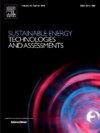An experimental investigation of phase change material (PCM)-enhanced cavity walls with integrated windows in office buildings: Optimising energy savings
IF 7
2区 工程技术
Q1 ENERGY & FUELS
Sustainable Energy Technologies and Assessments
Pub Date : 2025-06-10
DOI:10.1016/j.seta.2025.104381
引用次数: 0
Abstract
In this study, the optimal PCM position for energy-saving potential in multi-layered PCM wall buildings with windows has been investigated, focusing on moderating indoor temperatures and reducing heating and cooling loads. An experimental setup was constructed to measure the thermal behaviour of the PCM wall with a double-glazed window. The results indicated that the optimal PCM positions were in an arrange of 341 mm and 356 mm measured from the external surface of the wall through which the energy consumption for heating and cooling could be reduced by approximately 34–37% and yielded both a moderate PMV maximum value of 0.21 and a PPD value of 6.0%. As the PCM distance was increased from the outer wall layer to the inner wall layer, the heat transfer rate across the wall followed an exponentially decaying function combined with a sinusoidal component, influenced by a phase shift, amplitude modification, and a constant offset. This reduction in heat transfer was achieved through the PCM’s capacity to absorb and release latent heat, thereby stabilising indoor temperatures and reducing dependency on HVAC systems. These findings underscore the potential of PCM layers to contribute to the design of more energy-efficient and sustainable building and wall structures.
办公楼中相变材料(PCM)增强腔墙集成窗的实验研究:优化节能
在本研究中,研究了多层PCM带窗墙体建筑中PCM节能潜力的最佳位置,重点是调节室内温度和减少供暖和制冷负荷。建立了一个实验装置来测量带有双层玻璃窗的PCM墙体的热行为。结果表明,在距离墙体外表面341 mm和356 mm的位置,可使加热和冷却能耗降低约34-37%,PMV最大值为0.21,PPD值为6.0%。随着PCM距离从外壁层到内壁层的增加,壁面上的换热率受到相移、幅度修正和恒定偏移的影响,呈指数衰减函数与正弦分量相结合。这种传热的减少是通过PCM吸收和释放潜热的能力来实现的,从而稳定了室内温度,减少了对暖通空调系统的依赖。这些发现强调了PCM层在设计更节能和可持续的建筑和墙体结构方面的潜力。
本文章由计算机程序翻译,如有差异,请以英文原文为准。
求助全文
约1分钟内获得全文
求助全文
来源期刊

Sustainable Energy Technologies and Assessments
Energy-Renewable Energy, Sustainability and the Environment
CiteScore
12.70
自引率
12.50%
发文量
1091
期刊介绍:
Encouraging a transition to a sustainable energy future is imperative for our world. Technologies that enable this shift in various sectors like transportation, heating, and power systems are of utmost importance. Sustainable Energy Technologies and Assessments welcomes papers focusing on a range of aspects and levels of technological advancements in energy generation and utilization. The aim is to reduce the negative environmental impact associated with energy production and consumption, spanning from laboratory experiments to real-world applications in the commercial sector.
 求助内容:
求助内容: 应助结果提醒方式:
应助结果提醒方式:


